
Stability Ball Incline Dumbbell Chest Press: A Comprehensive Guide to Building Upper Body Strength
Introduction
The Stability Ball Incline Dumbbell Chest Press is an effective exercise for targeting the muscles in the chest, shoulders, and triceps. This compound movement not only helps build upper body strength but also engages the core muscles for stability and balance. In this comprehensive guide, we will walk you through the proper execution of this exercise, explain its benefits, and outline a step-by-step guide to incorporating it into your fitness routine.
Benefits of Stability Ball Incline Dumbbell Chest Press
Targeted Muscle Engagement: The Stability Ball Incline Dumbbell Chest Press primarily targets the pectoralis major muscles, which are responsible for chest development. Additionally, this exercise also engages the deltoids and triceps, leading to overall upper body strength and toning.
Increased Core Activation: Performing the exercise on a stability ball requires the engagement of the core muscles for stability and balance. As a result, the Stability Ball Incline Dumbbell Chest Press not only strengthens the chest but also helps develop a strong and stable core.
Improved Range of Motion: Unlike traditional chest press exercises, the stability ball surface enables a greater range of motion during the exercise. This increased range of motion allows for deeper muscle engagement, ultimately leading to better overall strength and muscle development.
Enhanced Stability and Balance: The unstable surface of the stability ball challenges your stability and balance, forcing your muscles to work harder to maintain control throughout the movement. This, in turn, helps improve overall balance and coordination.
Proper Execution of Stability Ball Incline Dumbbell Chest Press
Set-Up: Begin by placing a stability ball against a stable surface, such as a wall or bench. Position the ball so that when you lie back on it, your head, neck, and upper back are supported. Hold a dumbbell in each hand, with your palms facing forward.
Body Positioning: Walk your feet forward, bending your knees and positioning your feet firmly on the floor. Keep your knees at a 90-degree angle, ensuring they are aligned with your hips. Maintain a neutral spine, with your lower back pressed firmly against the stability ball.
Starting Position: Extend your arms fully, holding the dumbbells directly above your chest. Your hands should be shoulder-width apart, and your elbows should be slightly bent.
Execution: Inhale as you bend your elbows, lowering the dumbbells towards the sides of your chest in a controlled manner. Ensure that your elbows are at a 90-degree angle, forming right angles with your upper arms. Exhale as you push the dumbbells back up to the starting position, fully extending your arms.
Repeat: Perform the desired number of repetitions, maintaining proper form throughout the exercise. Focus on the quality of your movements rather than the quantity, ensuring that you feel the targeted muscles working throughout.
Incorporating Stability Ball Incline Dumbbell Chest Press into Your Fitness Routine
Warm-Up: Prior to performing the Stability Ball Incline Dumbbell Chest Press, it is crucial to warm up your upper body muscles. This can be done through a series of dynamic stretches and light cardio exercises, such as jumping jacks or skipping.
Frequency and Repetitions: Aim to perform the Stability Ball Incline Dumbbell Chest Press exercise 2-3 times per week, allowing for at least 48 hours of recovery between sessions. Start with 2-3 sets of 10-12 repetitions, gradually increasing the weight and intensity as your strength improves.
Progressive Overload: To continually challenge your muscles and promote strength gains, it is essential to incorporate progressive overload into your workout routine. This can be achieved by gradually increasing the resistance or weight lifted during each workout session.
Safety Considerations: When performing the Stability Ball Incline Dumbbell Chest Press, always ensure that you have a stable footing on the stability ball and maintain proper form throughout the exercise. If you experience any pain or discomfort, consult with a fitness professional to determine the cause and make any necessary modifications.
Conclusion
The Stability Ball Incline Dumbbell Chest Press is a highly effective exercise for building upper body strength, targeting the chest, shoulders, and triceps. By incorporating this exercise into your fitness routine, you can experience increased muscle engagement, improved core stability, enhanced range of motion, and better overall balance and coordination. Remember to always prioritize safety and proper form when performing this exercise, and gradually progress the weight and intensity as your strength improves. With consistency and dedication, you can achieve your upper body strength goals with the Stability Ball Incline Dumbbell Chest Press.
If you're looking for a gym, fitness club or yoga studio, you've come to the right place.
You can find information about gyms in your area. Browse catalog of gyms and find gyms with classes which are you looking for.
On gym page you can find simple information like address, phone or website. You can find list of available classes. You can check availability of personal training or small group classes. On place page you can also see information about open hours.
You can find gyms near you with amenities, courts, studios and equipments.
Use our map to find gym at your city or district.
In Gym Navigator you can find list of exercises with movies for many body parts.
You can browse exercises catalog and find exercises the best of you.
You can also find exercises grouped into workout plans, which you can use to improve you body. Each routine show you exercises one by one and give you possibility to count you progress and count down rest time.